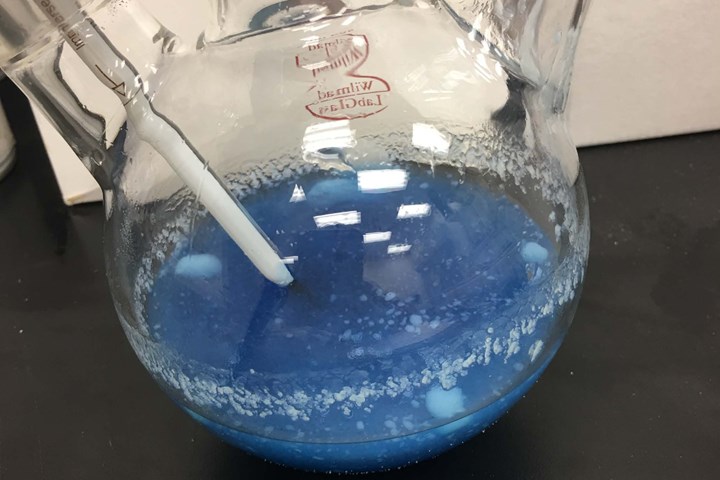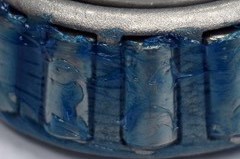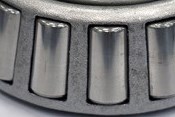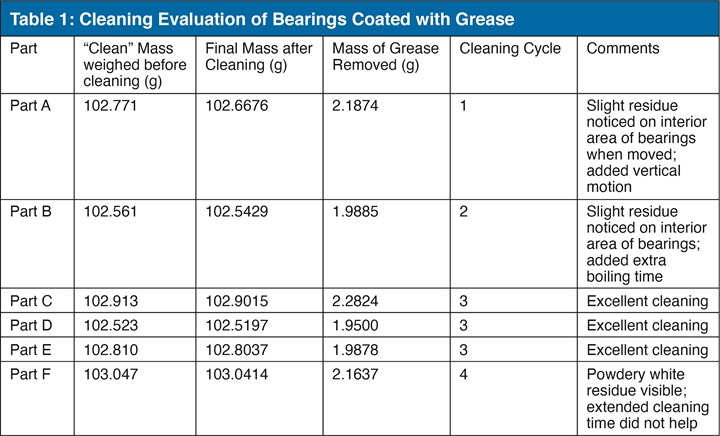
A cleaning evaluation conducted by the MicroCare Critical Cleaning Lab recently yielded a new cleaning formulation the company is calling MicroCare Synthetic Grease Remover.
A MicroCare (New Britain, Conn.) industrial fabrication customer needed a solution to remove a variety of synthetic greases from gears and bearings. The company’s technicians were originally cleaning parts by hand by soaking and scrubbing in flammable, hydrocarbon solvents for several hours. The company worked with Emerson (Danbury, Conn.) to select a vapor degreaser and a cleaning fluid to upgrade from a manual to a more automated cleaning process. After initial vapor degreaser testing using the customer’s contaminated parts, Emerson recommended their Branson B950R vapor. After one week of using the new system and various degreasing fluids, the engineers noticed that the cleaning was not complete. The specialty degreasing fluid removed the petroleum components of the synthetic greases but left a thick, heavy, white residue behind.

Bearings coated with grease
Critical Cleaning
Emerson reached out to MicroCare to conduct a cleaning evaluation in their Critical Cleaning Lab to solve the problem. Engineers brought new samples of bearings coated with the synthetic greases for a full cleaning evaluation. The MicroCare Critical Cleaning Lab chemists conducted an initial cleaning trial using the same methods and fluids as the customer. The results were the same as those the customer found; a coating of thick, white residue remained on the parts after cleaning.

Clean bearings
Trial and Success
Next, the MicroCare Critical Cleaning Lab chemists went to work developing a custom-blended cleaner that would fully remove this new generation of synthetic grease. These specialty synthetic greases contain various amounts of corrosion inhibitors and metallic salts mixed with organic and inorganic compounds, presenting a unique cleaning challenge.
Initially referred to by a prototype number, this new cleaning formulation soon became known as MicroCare Synthetic Grease Remover. This custom cleaning fluid met the synthetic grease cleaning challenge by breaking the grease down into its parts: the solvating agent cut through the organic components while the other ingredients lifted the inorganics and salts. All of the customers’ parts were then returned to the customer for evaluation. Satisfied with the results, the customer has selected MicroCare Synthetic Grease Remover as the solvent for their vapor degreasing system.

In MicroCare’s cleaning evaluation, parts were cleaned using various cleaning cycles ranging from 35-50 minutes.
The Analysis Details
The parts supplied by the customer were contaminated by about 2g of grease. Six different greases were sent for evaluation. Each of the parts was cleaned individually in an Ultronix BBMLR two-sump vapor degreaser. The parts were cleaned using various cleaning cycles ranging from 35-50 minutes. All parts were visually evaluated before and after cleaning as described in Table 1. Parts were examined at 10x magnification to identify any powdery, white residue left after cleaning. In addition, parts were weighed before and after cleaning.

All parts were visually evaluated before and after cleaning.
The customer also provided samples of each of the greases. A MicroCare-supplied bearing was evaluated for mass reduction before and after cleaning. The bearing was cleaned and weighed. Then the customer-supplied grease was added to the bearing and re-weighed. The bearing was then cleaned and a final weight taken to measure the amount of mass removed during cleaning. The gravimetrical data is listed in Table 2.

The amount of mass removed during cleaning is measured by weight.
Test Conclusions
The MicroCare Synthetic Grease Remover solubilized all of the grease and left minimal white residue behind which meets the customer’s cleanliness specifications. The grease remover holds at least 9.3% wt./wt. of grease in solution while remaining a homogenous solution. All of the test parts were cleaned in under an hour with minimal residue. A minimum of 20 minutes was suggested for boil immersion in order to remove the contamination. Longer boil times may be required for larger parts or heavier grease contamination. A rinse time of 5-10 minutes was suggested for any size part. Vertical agitation of the parts will also help break up any grease trapped in tight or interior areas of the parts and help promote thorough cleaning.
Efficiency gains and waste reduction
While the customer’s primary motivation in this study was to ensure parts cleanliness and to limit any residue that might impact further coating or finishing, the selection of MicroCare Synthetic Grease Remover has led to additional benefits.
The customer’s original manual cleaning methods required two days of cleaning that involved several steps including cleaning and drying. The new automated cleaning process, using the Branson B950R vapor degreaser and the MicroCare Synthetic Grease Remover, requires about 30 minutes.
The other new process improvements include:
- Less worker-hours required for cleaning
- Faster throughput of parts
- Less waste (the synthetic grease remover is self-cleaning inside the vapor degreaser)
- No drying processes required
- No water waste or water treatment needed
Summary
Through rigorous testing and focusing on the chemistry, the custom-formulated MicroCare Synthetic Grease Remover successfully cleaned the greases without any detrimental impact to the parts material or subsequent finishing processes. By matching the chemistry of the cleaning fluid to the parts substrate and the unique grease to be removed, the MicroCare Critical Cleaning Lab found a customized, yet simple and fast cleaning solution for its customer.
Read Next
Episode 45: An Interview with Chandler Mancuso, MacDermid Envio Solutions
Chandler Mancuso, technical director with MacDermid Envio discusses updating your wastewater treatment system and implementing materials recycling solutions to increase efficiencies, control costs and reduce environmental impact.
Read MoreA ‘Clean’ Agenda Offers Unique Presentations in Chicago
The 2024 Parts Cleaning Conference, co-located with the International Manufacturing Technology Show, includes presentations by several speakers who are new to the conference and topics that have not been covered in past editions of this event.
Read MoreDelivering Increased Benefits to Greenhouse Films
Baystar's Borstar technology is helping customers deliver better, more reliable production methods to greenhouse agriculture.
Read More










.jpg;maxWidth=300;quality=90)







